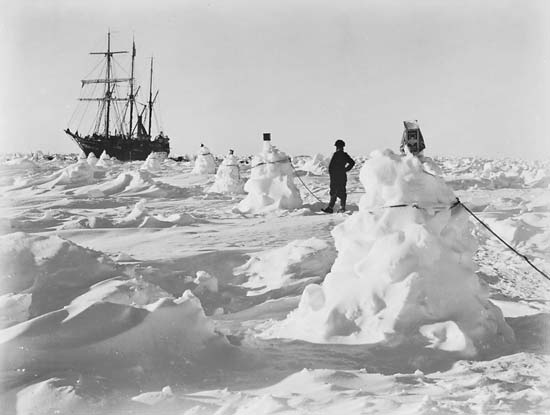Antarctic Expeditions History
The 20th century quest to reach the Antarctica had several explorers putting themselves to the test in the frozen Antarctic. Both Robert Falcon Scott from Britain and Roald Amundsen from Norway attempted to reach the Antarctic first in 1911. Both embarked on expeditions to the South Pole. It ended with a triumph for Amundsen, but a disaster for Scott.
In 1902, Scott tried to reach the Antarctic, but his team was compelled to return due to deprived health and wellbeing and temperatures below 0 °C. Scott had always intended to return. The Royal Navy and British government provided a £20,000 grant for him to pursue his ambitions. Scott mobilized men from his past Antarctic expedition just as the Nimrod Ship, which had quite recently gotten back from the Antarctic. His team was comprised of maritime sailors, researchers, and paying individuals. On June 15, 1910, the team’s Tera Nova ship set forth from Cardiff (Huntford 119).
Amundsen was a well-known explorer from Norway. He was adamant about beating the Antarctic exploration attempts from the British. His intention was to travel north but changed his goal after learning that the target had been beaten by Robert Peary in 1909. The Fram, Amundsen’s ship, arrived at Bay of Whales on January 14, 1911. The Norwegians earned a huge lead over their opponents, who preferred landing in McMurdo Sound (Huntford 312).
When Antarctic winter ended, Amundsen and his team started their journey to the Antarctic on October 18, 1911. Three weeks later, Captain Scott started on his journey. The Norwegian flag was raised at the Antarctic about 3 p.m. on December 14, 1911. Captain Scott arrived 33 days after the rival team had arrived at the Antarctic. On the 25th of January 1912, Amundsen’s team arrived at their camp site (Huntford 329). On November 1, 1911, Scott and his team set out for the Antarctic from their base camp. On 17 January 1912, he eventually managed to reach the Antarctic, only to discover that he lost the expedition to Amundsen. The long journey back was met with humility and modesty. As per the final diary entry dated March 29, 1912, Scott is weakened by fatigue, hunger, and intense cold. He died alongside two of his team members in their tent (Huntford 136).
There are several human resource lessons that can be learnt from the success of Amundsen’s team and the failure of Scott’s team in the race to the Antarctic. First, Human resource managers must ensure that their teams have a clear strategic focus (O’Connell 10). Initially, Amundsen aspired to be the first person to reach the North Pole. Amundsen shifted his focus to winning the race to the Antarctic after the race to the North pole was won by Robert Peary in 1909. Amundsen was able to achieve success because of his sole emphasis on this goal and no other. Scott, on the other hand, lost focus on both science and exploration priorities. As a matter of fact, when Scott and his men were discovered, they were hauling well over 100 pounds of Antarctic rocks back to England on their sleds. Scott’s unclear goals caused failure and death of his team.
Another lesson is that human resource management has a critical role in fostering innovation. Successful human resource managers are open to innovation. Innovation necessitates willingness to new ideas as well as the desire to learn from the past (O’Connell 26). There were inconsistencies between Amundsen and Scott in the management of their team members. The Norwegians attributed much of their accomplishment to the use of innovation in their journeys to the poles; including the use of skis, dogs, sleds, clothing and diet. Amundsen had also co-existed among the North American Eskimos to whom he owes his perfected techniques for polar survival and transport. Scott, on the other hand, was remarkably resistant to using these innovative techniques, and in spite of his inexperience, he was unwilling to rely on those who were familiar with the terrain. Scott tried unsuccessfully to use motor sleds and ponies, and he didn’t use dogs, dog sleds, or skis.
Finally, HRM must foster a culture of teamwork within the organization. It is also crucial to have confidence in your teammates. Teamwork allows organizations and staff to understand more about one another at work and how to work well with each other (O’Connell 43). As a human resource manager, Scott absolutely refused to implement any of his crew’s feedback. He claimed that as commander, he had full authority to assess conditions and make the appropriate decision. Amundsen built on his crews’ previous experiences. This may well be due to the fact that Amundsen had served in the merchant marine fleet of Norway, while Scott had served as an officer in the Royal Navy in the UK.







